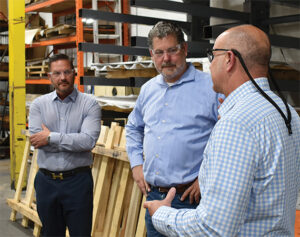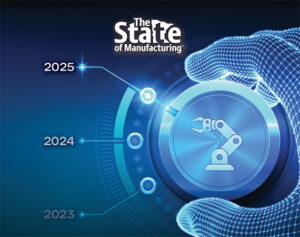At Enterprise Minnesota’s State of Manufacturing® event in November, Doug Woods tells manufacturers they will flourish by capitalizing on technology, new markets, and thriving industries.
As an industry expert, Woods believes there couldn’t be a better time to be in manufacturing. He was born into the industry and has spent more than four decades in leadership capacities at different companies. Woods’ long view is that manufacturers have golden opportunities to thrive — even if they are facing some current obstacles.
From recent government investments in infrastructure to the promise of automation, manufacturers have rich opportunities for growth. And they have ever-evolving tools to help them do their work faster, better, and leaner, Woods says. These boons to business will help Minnesota manufacturers power through challenges like the rising costs of health care and benefits, coupled with inflation.
“It’s almost ‘kid in a candy shop’ time,” says Woods, president of the Association for Manufacturing Technology (AMT) in Virginia.
“Two million jobs have been reshored in the last 11 years. And we’re one of the biggest locations for foreign direct investment in new manufacturing facilities,” Woods says. Thanks to the 2020s enactment of the Inflation Reduction Act, Infrastructure Investment and Jobs Act, and the CHIPS and Science Act, “there are trillions being spent. There’s an acceleration of work for the U.S. Department of Defense with what we’re giving to our allies. Then there’s the fact that we’re the biggest consumption market, and consumer spending is at fairly elevated levels. All of that has to be manufactured.”
Add in a stunning array of technology advancements. To Woods, the promise of manufacturing is readily apparent when AMT hosts the International Manufacturing Technology Show (IMTS), its biannual event in Chicago. He gets astounded by the vast array of technology that will help companies improve operations and break into emerging fields.
“There is a lot of great new technology driving manufacturing to places where it couldn’t have gone a decade or two ago,” Woods says. “Think about what you can do with generative artificial intelligence, advances in additive manufacturing, augmented reality or virtual reality, cognitive automation, advances in robotics, and advances in materials.”
Macro perspective
Woods’ view of manufacturing began with childhood weekend visits to his grandfather’s tool and die company in New York. He followed in his grandfather’s footsteps, inspired by his passion for manufacturing and innovation. During 27 years in the industry, Woods rose from apprentice to CEO while specializing in automation technology and equipment.
He took the helm of AMT in 2009 intending to stay five years, but he inherited his grandfather’s thirst for pairing innovation with manufacturing excellence. Today, he is motivated to continue making a positive impact on the country’s manufacturing industry. That aligns with AMT’s mission to help manufacturing technology companies navigate global markets and provide them with industry and market intelligence. AMT also assists manufacturers with assessing new technologies and developing insights through surveys, research, and other data.
Woods’ tenure in manufacturing gives him a cool head about its challenges, providing him with the perspective that the industry does experience cyclical down times. However, manufacturers can propel themselves forward by focusing on enhancing their operations with technology or making capital investments that improve operations and productivity. A recent proof point: An AMT survey found that companies making the most capital investments perform the highest in profit margin, revenue, and growth.
Though Minnesota manufacturers currently feel pessimistic, Woods wants them to know that industry analysts and experts see sunny skies ahead. At AMT’s annual MTForecast Conference in October, its guest economists, market segment analysts, Federal Reserve representatives, and leaders from end markets like aerospace, automotive, and energy collectively reported being very positive about market opportunities for manufacturers, he says.
The outlier is Minnesota manufacturers, who are anxious about how recent legislative requirements for earned sick and safe time plus paid family and medical leave will affect them. “What I’m seeing in Minnesota is what I would consider a self-inflicted wound, which is different from other places in the United States,” Woods adds.
Get proactive
To grapple with challenges, manufacturers have levers to pull to keep their businesses prospering. One critical step that Woods recommends is investing in technology, focusing especially on ways to improve operations. It’s critical to be smart about what technologies to adopt, he says. It’s not one-size-fits-all, and it doesn’t have to be bleeding edge.
There is a wealth of options to consider, from new machine interfaces and optics to high-speed machining. Manufacturers also have big opportunities with robotics, which can ramp up production or pitch in when staffing is short. To find the right technology, manufacturers should identify their top five problems and then seek out options to solve them.
“There are a lot of things at cost points that are very affordable, where they can bring technology into their facility to increase production and help with uptime,” Woods says. “We counsel our members to be very focused and not go after the shiny object. Look for something that will have a useful impact on their business.”
Lately, another way to thrive involves becoming a supplier to the U.S. Departments of Defense and/or Energy. Both are trying to make it easier to work with them. Plus, ramped up spending on military materiel and new investments in clean energy are providing hearty opportunities for manufacturers.
A final avenue for growth involves branching out into new global markets. There are organizations like AMT aligned with different segments of the industry, such as the National Tooling & Machining Association or the Precision Machined Products Association. They offer intelligence and guidance to manufacturers on growing global business.
With these approaches, Woods is confident manufacturers will persevere through the tough times as they consistently do. “There is always something new and creative you can try, whether it’s finding new ways to create your products, bringing in automation, using software or hardware, or finding new end markets,” Woods says. “If you are interested in building technology to solve problems, there are endless problems to solve. This is probably one of the best times in the world to be in manufacturing.”
Return to the Winter 2024 issue of Enterprise Minnesota® magazine.


